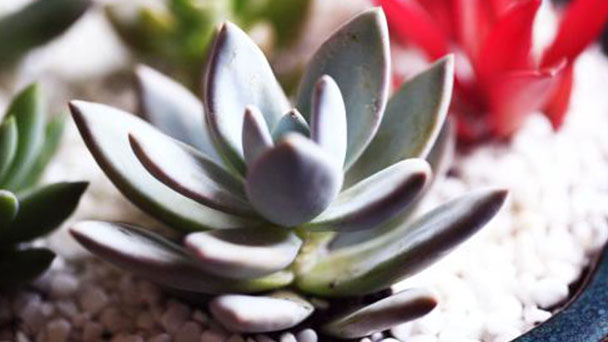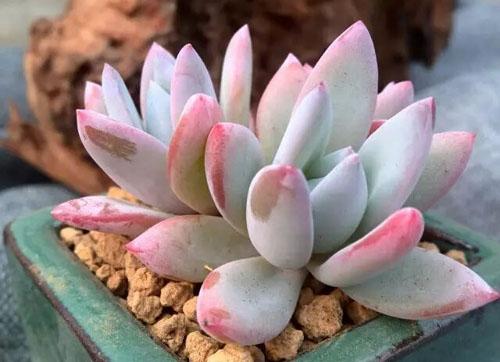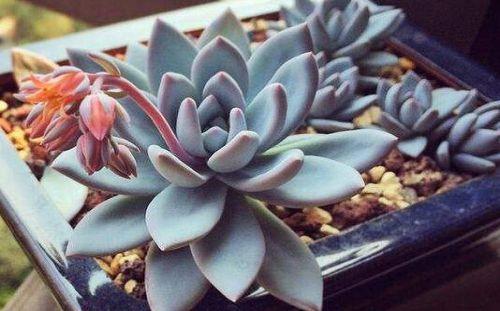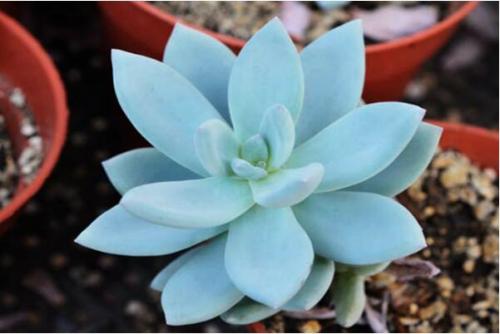Echeveria Simonoasa profile
Written by Maggie
Mar 10 2021

Echeveria Simonoasa is a succulent plant of the Chloridaceae family. It is a hybrid between Pachyphytum Oviferum and Echeveria Cante in the 1970s. They prefer a warm, sunny, dry and ventilated environment. They are drought-resistant, cold-resistant and adaptable. The leaves have a natural layer of thick white frosting, which makes the plant appear pale blue at first sight.
Echeveria Simonoasa picture

Echeveria Simonoasa morphological characteristics
Echeveria Simonoasa is a perennial glabrous succulent plant with annular, flat, long-fusiform leaves, pointed, arc-shaped leaf margin, thickened leaves, angular back leaves, sunken leaves, and slightly curved leaves toward the center. Leaves are smooth white powder, after wiping the white powder covered greenish-blue or grey-green, white powder does not regenerate. Leaves are closely arranged in full sunlight, lavender or pink leaf. Under low light conditions, the leaves are light blue or blue-green. The leaves become narrow and long, and the spacing between the leaves will lengthen. Racemes of pink flowers on the outside and orange on the inside, bell-shaped, serially arranged, five or six. echeveria simonoasa blooms in early summer.
How to grow and care for Echeveria Simonoasa
Echeveria Simonoasa is a succulent plant variety that is easy to maintain. It has strong adaptability and prefers dry, well-ventilated and sunny environments. It likes sandy soil and is not resistant to dampness.
Light
Echeveria Simonoasa leaves will be more colorful and moist with more light and greater temperature difference between day and night. In the case of appropriate temperature, it is best to put the outdoor maintenance, to ensure adequate light. When the illumination is insufficient or the soil moisture is too much, the whole plant will be dull and greenish in color, the leaves will be sparsely spaced and elongate, accelerating the upward growth, which will seriously affect the ornamental value, and even cause the death of the plant due to the blocked photosynthesis. Pay attention to ventilation when in summer high temperature, to prevent exposure to the sun in the outdoor time, so as not to burn.
Moisture
Due to the high moisture content within the Echeveria Simonoasa plant, the frosted side is prone to rot under excessive humidity. Never water too much. In order to avoid the root water silting, it is best to choose the basin with a drainage hole at the bottom, the novice planting can choose a good air permeability of the red pottery basin
In winter and summer, when the temperature is too high (above 35℃) or too low (below 5℃), the plant stops growing or growth slows down. At this time, the watering frequency should be reduced or temporarily stopped, and the watering frequency should be resumed when the temperature is suitable.
Reference watering quantity: 10 days or so once, each time can be thoroughly watered. Watering frequency can be increased or decreased according to the climate difference between different regions and seasons.
It is important to note that when watering, do not pour water on the center of the plant (which can easily lead to rot) and try to prevent the leaves from remaining too much water (white powder on the leaves is easy to wash off).

Soil
It is advisable to cultivate Echeveria Simonoasa in a well-drained and breathable sandy soil for the removal of excess water and the growth of plant roots. One part of peat, vermiculite and perlite respectively, and an appropriate amount of bone powder is added. It can also be prepared by mixing 3 parts of leaf mould, 3 parts of river sand, 1 part of garden soil and 1 part of furnace slag. Change basins every 1 to 2 years in the spring. Necrotic old roots and over lignified stems can be cut off to avoid affecting the normal growth and water absorption of the plant.
Temperature
Generally, Echeveria Simonoasa stopped growing or suffered mild frostbite when the temperature was below 5 ℃, and the water-frozen cells in the leaves were dead at 0 ℃ or below.
Trim
In normal times, the old leaves of dried Echeveria Simonoasa should be removed in time to avoid accumulation and breeding of bacteria. When the plant grows too long or too high, the top branches and leaves can be pruned to shape and control the height of the plant, so as to maintain the elegant shape of the plant. The top part of the cut can be inserted into the sandy and damp soil after the wound is dried and become a new plant. More lateral buds can sprout from the stem and leaves at the bottom.
Echeveria Simonoasa main value
Echeveria Simonoasa leaf shape is of excellent color. The plant is compact, like a rosette carved with jade pieces. The old plants with many heads have a sense of blossoming. The elongated stems of the old perennial plants become bonsai. The leaves are very full, showing a hazy and dreamy mauve, with lovely elegance.
The thick leaves of the frost dynasty have subtle color, as if sprinkled with powder, and are particularly beautiful.A leaf falls in the circumstance with abundant sunshine, can maintain the state like rose petal, adorn windowsill and desk very beautiful.

Echeveria Simonoasa leaf insertion propagation
Leaf blade choice
Leaf cutting before to do the most important step to choose, choose only the most robust living Echeveria Simonoasa leaf, leaf will increase the chances of success, general will plug in the spring and autumn period and the two seasons, this time is that it's rate of growth, leaf cutting rooting and growth, picking leaves a few days ago to stop water, so that better pluck blade, choose leaves when looking for that kind of 1, 2 years of relatively full hard blade, don't, there is any breakage or pests a hand gently knead a blade, or shake can take down, efforts must be small,Otherwise it will damage other leaves, the blade is better than the cutting tool cut down, because the wound area is very good, the basic dry dry for 1 day.
Leaves the soil
Leaf cutting Echeveria Simonoasa typically with wide mouth shallow flower pots, wide mouth can put more blade, and the new Echeveria Simonoasa roots plunge into is not deep, so don't need how long flower pots, about 10 cm, lobes inserted to choose fertile soil and water retention stronger soil, we can prepare some peat soil with river sand and vermiculite, the soil is basic can meet Echeveria Simonoasa leaf cutting rooting conditions,It will also encourage the growth of small Echeveria Simonoasa plants. Pour all the soil into the pot and smooth it, leaving about 3cm from the top of the pot so that the leaves are ready for planting.
Leaf cutting process
If home have abt in plug can dip in some leaves, and roots of time will be faster, with watering can slowly on the basin soil spraying again, all the top soil wet injection, and then carrying on the blade face gently flat out on the soil, arranged as far as possible some beautiful and tidy, each blade pitch 3, 5 centimeters, so that you can, spread can end the flower pots to a cool ventilated place, waiting to take root, if the soil during dry and needs in a timely manner to fill some water, but don't put on to the leaf, could easily lead to leaf rot,Within about three weeks of proper care, Echeveria Simonoasa will grow thin roots, and then it can wait for new shoots to grow from the wound on the leaf.
The plant can be moved to a place that receives a little bit of weak scattered light, which will facilitate the growth of Echeveria Simonoasa under the condition of good photosynthesis. Then the plant can be watched as the new plant grows slowly, and when it grows to a certain point, it can be planted separately.
Latest Updated
- Benefits of Bugleweed - 7 Science-backed Health Benefits
- Bugleweed Dangers & Side Effects - Is It Poisonous?
- How to Plant Evergreen Trees - What You Should Know
- When to Plant Evergreens - Grow Guide for Evergreen Trees
- 12 Wonderful Evergreen Shrubs for Your Garden
- 12 Popular Evergreen Plants with Pictures for Beginners
- When And How To Prune A Lilac Bush Like a Pro
- How to Grow & Care for Lilac Vine (Hardenbergia Violacea)
- Japanese Lilac Tree (Syringa Reticulata) Care & Propagation Guide
- Shumard Oak Pros and Cons - What to Know
Popular Articles
- Winter maintenance of Antirrhinum Majus
- How to Grow Terminalia Mantaly Tree
- How to Grow and Care for Crossostephium Chinense
- How to grow Antirrhinum Majus in spring
- Peristeria Elata (Dove Orchid) Profile: Info & Care Guide
- Underwatered Snake Plant (Sansevieria Trifasciata) - Signs And How To Fix
- How to Care for Brazilian Jasmine Plant (Mandevilla Sanderi)
- How to Grow & Care for Graptopetalum Purple Delight in Summer
- Rosa Chinensis (China Rose): Plant Growing & Care Tips
- How to Care for Baby Sun Rose (Aptenia Cordifolia)